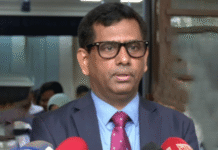
In a muddy field in western Myanmar, hundreds of Chinese shipping containers fitted with single narrow windows stand in neat lines, empty of the refugees they were designed to host.
The gray boxes were sent by China two years ago as quick and cheap housing for some of the hundreds of thousands of Rohingya Muslims who fled Myanmar for Bangladesh during a military-led crackdown in 2017 that the United Nations said was conducted with genocidal intent.
The empty containers, situated near the town of Maungdaw in Rakhine state, reflect months of failed efforts to entice the Rohingya to return to Myanmar despite a diplomatic drive by the country’s close ally and neighbor, China.
In a sharp departure from its official policy of non-interference in the affairs of other countries, China has positioned itself as the key mediator in resolving the protracted crisis. But like the Indonesian and United Nations envoys who previously attempted to mediate between the parties, China is finding the business of diplomacy tough going, with little signs that the crisis will soon be resolved.
The main sticking point is a disagreement over whether the refugees will be safe in Myanmar.
Myanmar says it has created safe conditions for the Rohingya’s return, but Bangladesh and the United Nations say that fighting in Rakhine and a lack of human rights guarantees make a return for the refugees dangerous. The Rohingya, meanwhile, say they will not go back without guarantees of rights they are currently denied, including citizenship and freedom of movement.
Over the past two years, Chinese officials have brokered three meetings between leaders of the two countries, made multiple visits to the sprawling refugee camps housing the Rohingya in Bangladesh, hired cattle trucks to bring returnees home and even offered cash inducements, all to no avail.
Still, China says it has made progress, even if only a few hundred Rohingya have returned home so far.
The issue received fresh attention when president Xi Jinping traveled to Myanmar on Friday for a two-day state visit. In a joint statement from both countries published after the visit, China reaffirmed its willingness to continue to mediate, while Myanmar thanked China for “its understanding of the Rakhine problem, its difficulty and complications”.
The main focus of Xi’s visit was the massive Chinese infrastructure projects, including a controversial hydropower dam and a deep-sea port in Rakhine, that make Myanmar a vital link in his flagship Belt and Road Initiative aimed at expanding trade links across the world.
The two countries signed dozens of deals covering trade and infrastructure, with Myanmar agreeing to speed up implementation.
Western Myanmar, sitting between booming India and Southeast Asia, is strategically important to Beijing, offering China’s landlocked western provinces potential port access to the Indian Ocean and the Bay of Bengal.
“We have facilitated and hosted three foreign minister meetings between China, Myanmar, and Bangladesh to work for an early repatriation,” Luo Zhaohui, China’s vice foreign minister told reporters on 10 Jan. in a press conference ahead of Xi’s trip. “Our efforts have paid off,” he said.
But Bangladeshi officials, Western diplomats in Yangon, and security analysts say that China is mainly concerned with shoring up its key interests in Rakhine.
In discussions with the Bangladesh government, Chinese officials emphasise the importance of developing the state rather than resolving human rights issues, according to a Bangladeshi official familiar with the discussions.
“China wants to resolve the crisis,” said another Bangladeshi official. “At least, they want to start repatriation as early as possible. But they are not doing enough to oblige Myanmar to create a conducive environment for them to return.”
UN officials and diplomats in Yangon also say that China’s efforts to broker a quick solution ignores the human rights concerns.
“Their approach is wildly simplistic,” said one Yangon-based diplomat. “What we hear is China has been pushing Myanmar and Bangladesh to just get it done. What does that mean when the conditions aren’t there?”









